Charger LiitoKala Engineer 300
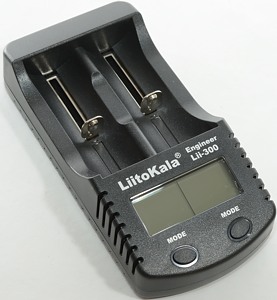
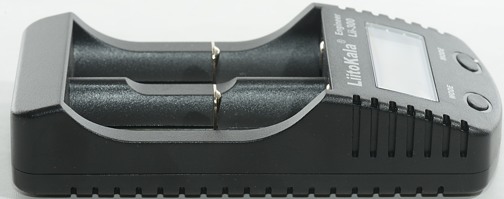
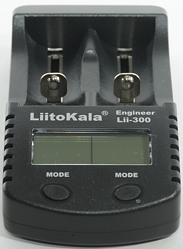
LiitoKala started by making a analyzing LiIon charger (Engineer 260) that was fairly useful, but had a problem with long cell and the ohm reading. This is an updated version of the charger that can handle longer cells, works with both LiIon and NiMH and has a USB power bank function. How well did the update go?
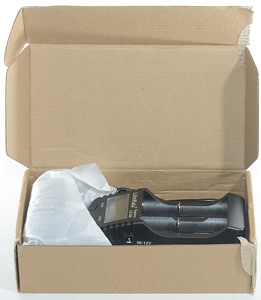
It arrived in a nondescript cardboard box.
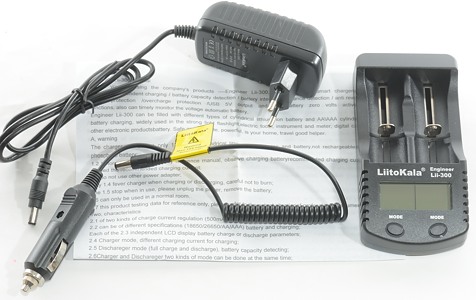
In the box is the charger, a power supply, car adapter and an instruction sheet.
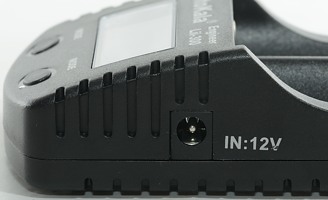
The charger has a 12 volt DC power input, for the mains adapter and the car adapter
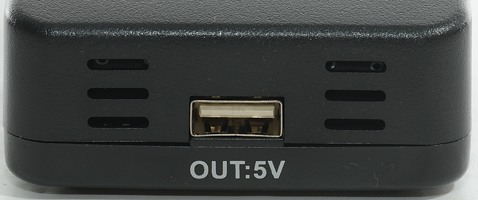
On the back of the charger is a usb output.
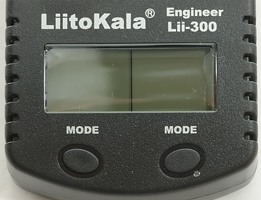
The display has two sections one for each battery. The two buttons is also one for each battery.
Each time a battery is put into the charger it will measure the internal resistance of the battery. Then start flashing with 500.
A short press on the corresponding button will change between 500/1000mA charge current, a long press will select discharge. The charge current must still be selected. I.e. the charger can charge with 500 or 1000mA, but only discharge with 500mA.
When the button is not pressed for some seconds, that slot will start working.
During charge it is possible to toggle the display between mA, mAh, h (Charge time in minutes), mR (Internal resistance) with the button, voltage is always shown.
The display has background light, but it turns off rather fast.
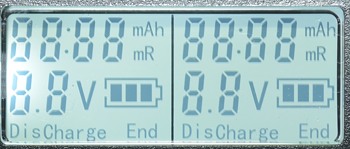
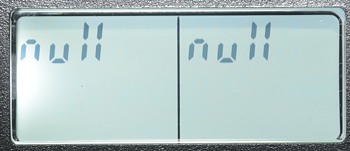
When turned on the charger will show everything on the display for a short time, then change to "null" if the slots are empty.
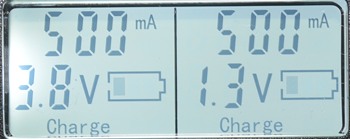
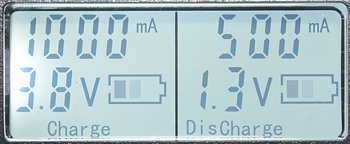
Charging with 500mA, one LiIon and one NiMH, the battery symbols are animated. Selecting discharge will not immediately start discharge, but will first fill the battery. The animation on the battery symbol shows if the charger is charging or discharging.
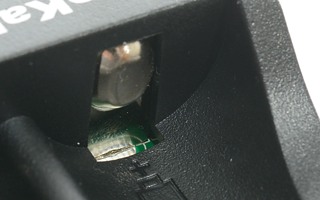
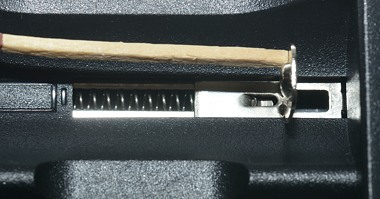
The slots uses the common slider design with bumps on the plus and minus connections, this makes the charger work with both flat and button top batteries. The sliders works good and support from 30mm to 70.0mm. This will still give problem with the longest cells, especially some protected 26650 cells.


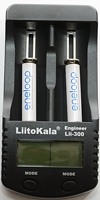
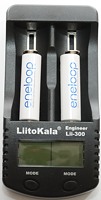
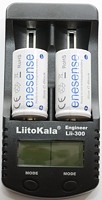
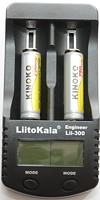
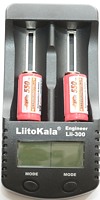
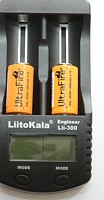
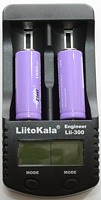
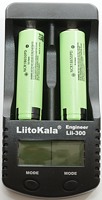
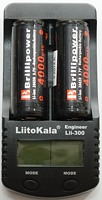
The charger can handle 70 mm long batteries including flat top cells.
Measurements
- When not connected to power it will drain about 1.2mA from batteries.
- Voltmeter is within 0.1V.
- The voltmeter will freeze when charging is finished
- The voltmeter will show up to 4.3 volt (Maybe more).
- The charger will always charge with full current.
- Above 2 volt the charger assumes LiIon.
- Charger always starts with the 0.5A setting.
- When charge is finished the charger will charge with 0.5mA.
- Charger will not restart if voltage drops
- Charger will restart charging after power loss, or battery insertion.
Charging LiIon
%20%231.png)
This is a good CC/CV charge curve with a termination around 100mA.
Display shows 2457mAh in 3:27
%20%232.png)
Slot two is the same.
Display shows 2664mAh in 3:18
%20%231.png)
%20%231.png)
Other capacities does also work fine.
Display shows 2251mAh in 3:31 and 3035 in 4:06
%20%231.png)
Charging at 0.5A works fine, but I would have liked a lower termination current. 0.1A is too high for many cells and they will not be filled completely.
Display shows 2720mAh in 5:52
%20%231.png)
%20%231.png)
Both the smaller cells works fine at 0.5A.
Display shows 702mA in 1:40 for the 18350 and 775mAh in 1:50 for the 14500 cell.
%20%231.png)
It can also charge my old 16340 cell, but the high termination current means very little capacity is filled into it.
Display shows 153mAh in 0:37
%20%231.png)
Reducing the charge current does not help much, because the termination current is unchanged.
Display shows 162mAh in 0:38
.png)
There is no problem charging two cells at the same time.
.png)
The charger uses below 1A on the 12 volt input.
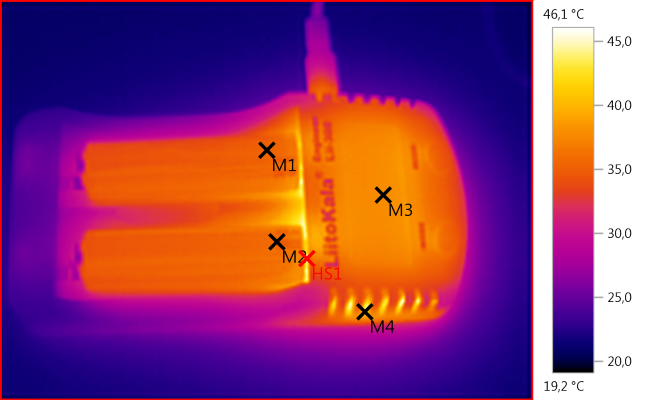
M1: 35,5°C, M2: 35,4°C, M3: 37,9°C, M4: 42,3°C, HS1: 46,1°C
The temperature is acceptable while charging LiIon.
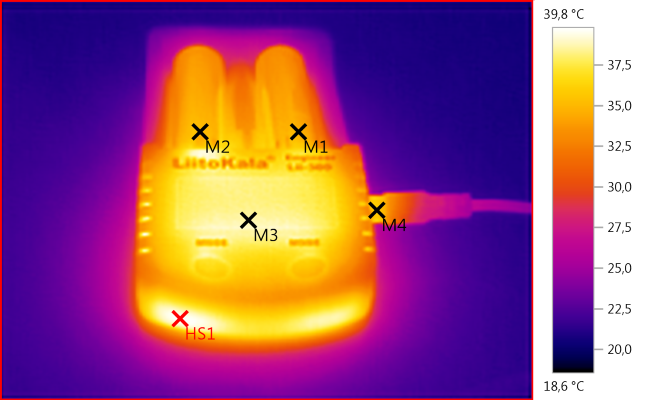
M1: 34,7°C, M2: 35,2°C, M3: 38,6°C, M4: 35,8°C, HS1: 39,8°C
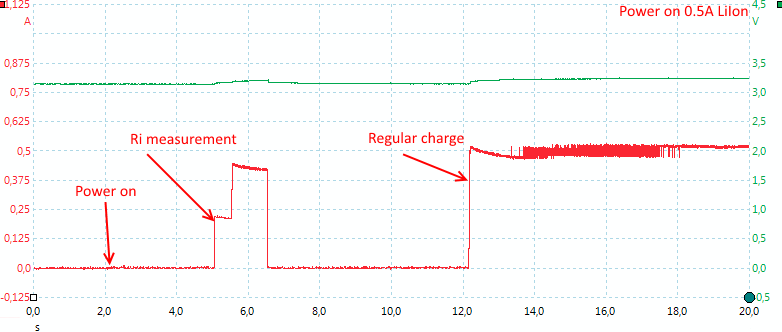
The charger is a bit slow to start, because it is giving the user time to change current (Current is locked while charging).
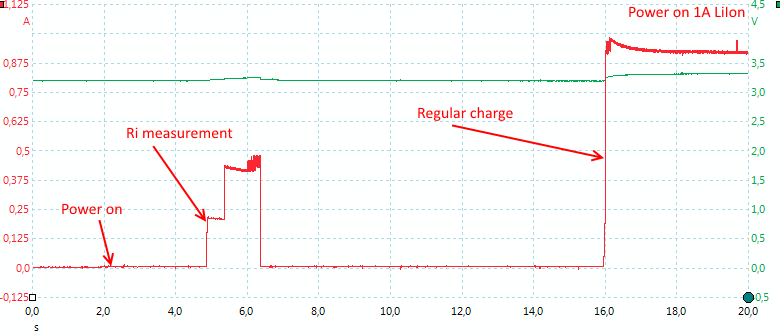
When I selected 1A current it extended the period I could change current in.
Discharging LiIon
The charger has a discharge function that is fixed at 0.5A discharge current.
%20%231.png)
Here I uses the default 0.5A charge current and the battery is charged with 0.5A, then discharge with 0.5A and finally charged again with 0.5A. There is no rest between charging and discharging.
Display shows 2811mAh in 5:37, this is the capacity and time for the discharge.
%20%231.png)
Same as above, this time with 1A charge current.
Display shows 2917mAh in 5:50, this is the capacity and time for the discharge.
%20%232.png)
The second channel works exactly the same way.
Display shows 2884mAh in 5:45, this is the capacity and time for the discharge.
.png)
Using both channels at the same time generates some heat. This heat is probably the reason the discharge is restricted to 0.5A.
Display shows 2910mAh in 5:49 and 2993mAh in 5:59
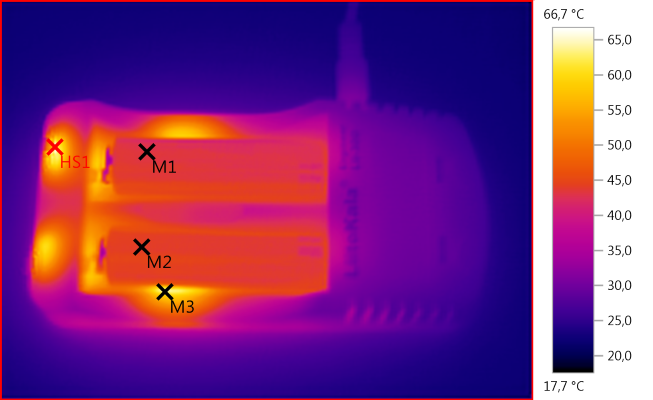
M1: 43,3°C, M2: 44,1°C, M3: 63,3°C, HS1: 66,7°C

M1: 44,3°C, M2: 43,3°C, M3: 63,9°C, HS1: 70,9°C
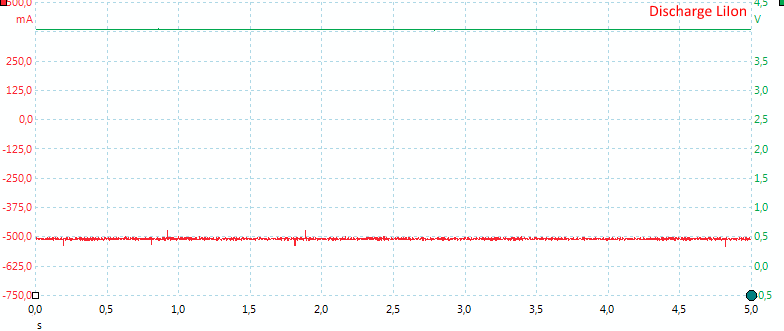
No pulsing, but a smooth discharge current (Nearly, see NiMH discharge).
Measuring resistance of LiIon
The charger measures the resistance of a battery each time it is put into the charger, this is usual a good function to see how worn the battery is.

All measurements are done with the same LiIon cell, this is not obvious from the numbers. In the first row contact resistance can be used as excuse, but all the other measurements have fairly stable resistance.
This is not useable.
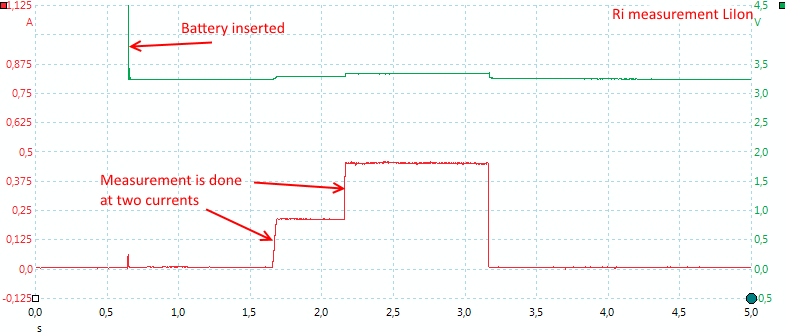
The measurement is made about 1 second after the battery is put into the charger.
Charging NiMH
%20%231.png)
A fairly constant charge current with a voltage termination and no top-off or trickle charging, i.e. the battery is not filled completely. This can also be seen on the temperature track, there is no final increase.
Display shows 1828mAh in 1:56.
%20%232.png)
Second channel works the same way.
Display shows 1781mAh in 1:53.
%20%231.png)
A lower charge current makes the it slower, but fills the battery to about the same level.
Display shows 1739mAh in 3:41.
%20%231.png)
Not much capacity in my XX cells with this charger.
Display shows 1861mAh in 1:58.
%20%231.png)
The pro cells has a slightly lower charge voltage and get charged nearly full.
Display shows 2434mAh in 2:35.
%20%231.png)
Same with the powerex
Display shows 2401mAh in 2:32.
%20%231.png)
Display shows 597mAh in 1:16.
%20%231.png)
With voltage termination a full cell is detected fairly fast.
.png)
When charging NiMH the charger requires less than 0.5A current.
Display shows 1778mAh in 1:53 and 1825 in 1:56.
.png)
The NiMH charging requires less current than LiIon charging, the charger only less than 0.5A on the 12 volt input.

M1: 37,4°C, M2: 38,6°C, M3: 37,6°C, HS1: 52,2°C
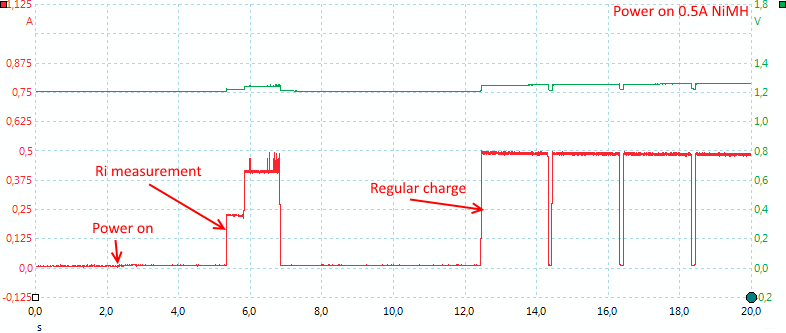
The charger always does a measurement of internal resistance in the cell, before starting charge.
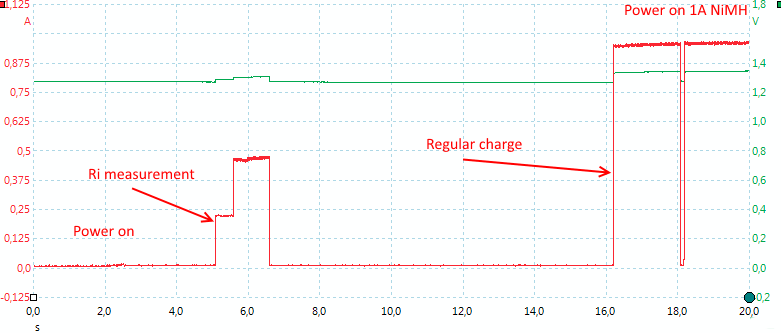
Changing charge current will delay the charge start a bit.
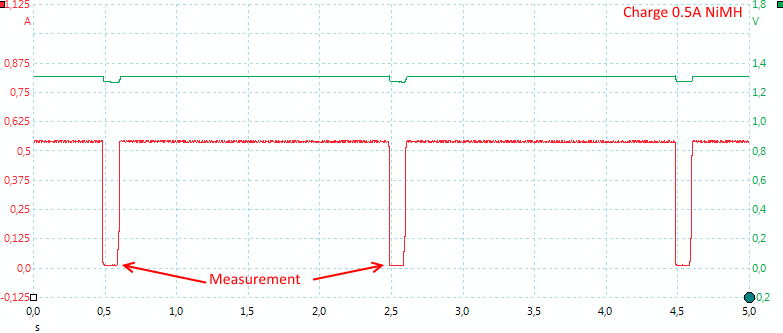
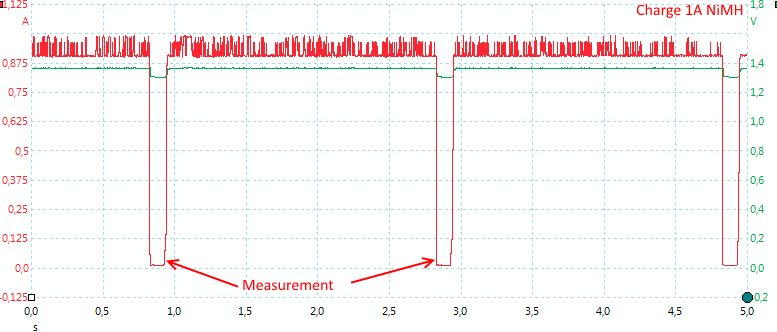
The charger stops every 3 seconds to measure the voltage on the NiMH battery.
Discharging NiMH
The charger can also discharge NiMH batteries.
%20%231.png)
This works the same way as LiIon, i.e. charge, discharge, charge. The discharge current is always 0.5A, but charge current can be selected.
Display shows 1912mAh in 3:49, this is the capacity and time for the discharge.
%20%231.png)
Display shows 1938mAh in 3:52, this is the capacity and time for the discharge.
%20%232.png)
Display shows 1914mAh in 3:49, this is the capacity and time for the discharge.
.png)
Two eneloop do not generate much heat.
Display shows 1921mAh in 3:50 and 1968mAh in 3:56.
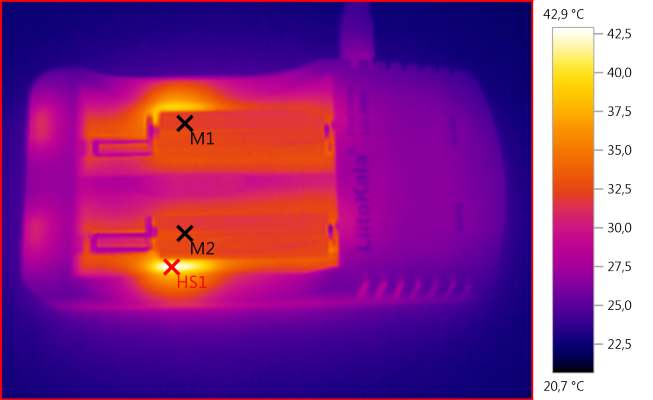
M1: 32,1°C, M2: 32,6°C, HS1: 42,9°C
Discharging NiMH is about 1/3 the power, compared to LiIon, there is no problem keeping the battery temperature down.
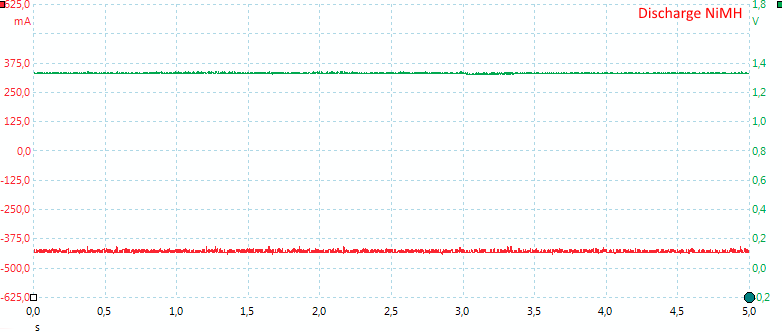
Also with NiMH the discharge current is a nice constant current.

But if I remove my filters and look at the current with a fast time scale, they are not really that stable. The charger uses some very fast pwm to control the discharge current.
Measuring resistance of NiMH
The charger measures the resistance of a battery each time it is put into the charger, this is usual a good function to see how worn the battery is.

All measurements are done with the same NiMH cell, this is not obvious from the numbers. In the first row contact resistance can be used as excuse, but all the other measurements have fairly stable resistance.
This is not useable.

The measurement is made about 1 second after the battery is put into the charger.
Mixing LiIon and NiMH when charging
In these charts the temperature sensor is on the opposite battery.
.png)
In the first chart I measure on the eneloop while charging, it is charged as usual.
.png)
The LiIon also looks as usual. The temperature drops when the NiMH is finished.
USB output
- USB output is coded as Apple 1A
- There is no indication of usb output active
- USB output is draining the batteries with 1.2mA when unloaded.
- USB output is disabled when the charger is powered.
- USB output uses both batteries for power.
- The usb output is disabled when the battery drops below 2.7 volt.
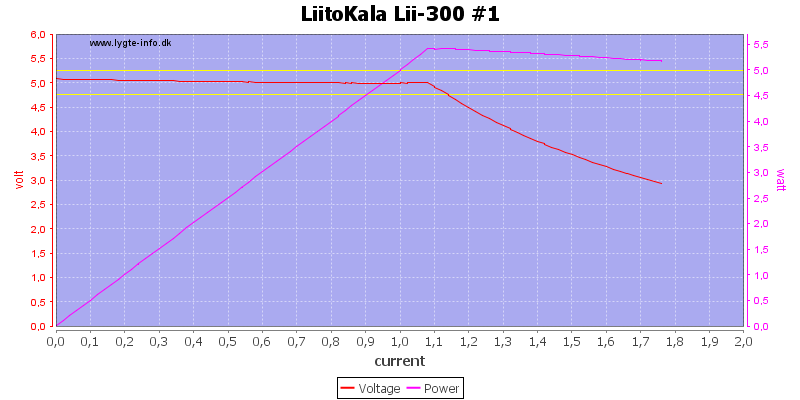
As usual I do a load sweep first, to see how the output works at different loads. The charger can deliver 1.1A and then the output starts dropping, there is no sign of any overload protection.

Using second battery slot works nearly equal.
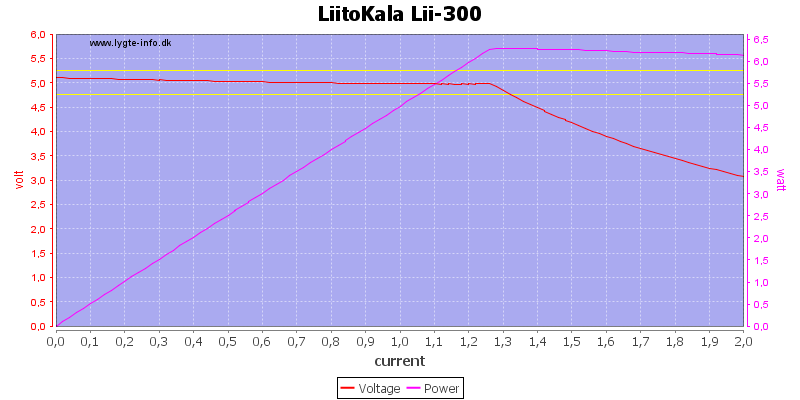
With batteries in both slots it can only deliver slightly more current.
%20%231.png)
First run is with 1A load, the usb output can maintain that for about 10 minutes and has a bad efficiency.
%20%232.png)
Second slot is the same.
.png)
Using both slots do improve the output significantly, now it can maintain 1A load for 80 minutes.
The two batteries are discharged at the same rate.
Note: Efficiency calculations are wrong.
%20%231.png)
1A did not work very well, what about 0.5A. It is better, it can maintain the output for about two hours, but the efficiency is not that good.
%20%232.png)
Second slot is the same.
.png)
Using two batteries improves it, now it can maintain output for more than 5 hours.
Note: Efficiency calculations are wrong.

With 28mV rms and 186 mV peak-peak noise the output voltage is fairly good.
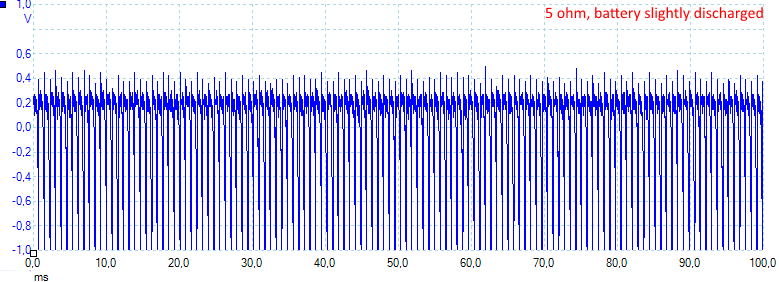
But that is only valid for a short time, when it drops out of regulation the noise is hopeless.
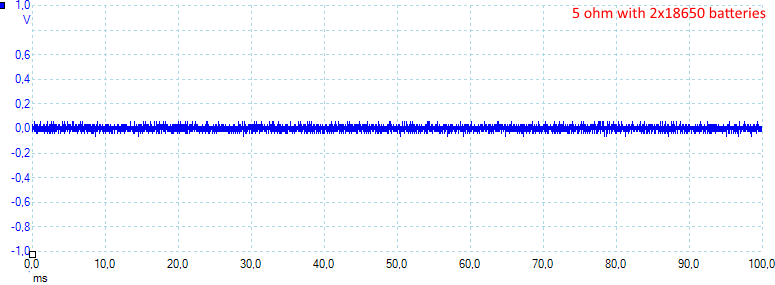
Using two batteries the noise is 23mV rms and 140 mV peak-peak.

With 0.5 load the noise goes down to 10mV rms and 79mVpp.
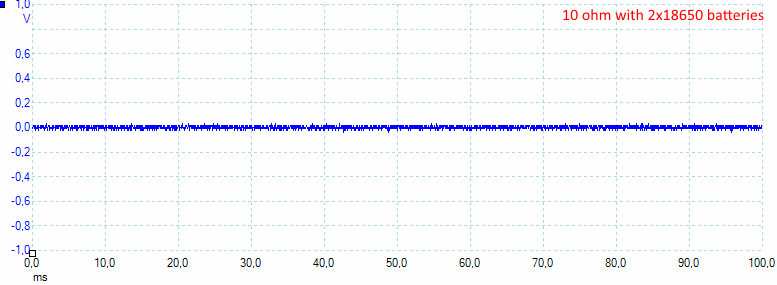
Using two batteries with 0.5 load is about the same at to 10mV rms and 74mVpp.
With 1A load the rms noise increases to 11mV and the peak-peak to 800mV, again a good value.
Testing with 2500 volt and 5000 volt between mains and low volt side, did not show any safety problems.
Conclusion
The charger handles larger LiIon fine, but due to the high termination current it is not perfect for 16340 and 14500, but useable.
With NiMH it uses the common voltage termination and without a few hours top-off this means that the batteries will be slightly undercharged, this is usual not a problem.
The battery resistance measurement is not useable they way it works now.
The usb output can be used in an emergency, but is not very good.
It is a nice charger for maintaining batteries with the capacity measurement, for both LiIon and NiMH, but forget the resistance measurement and the usb output.
Notes
Here is an explanation on how I did the above charge curves: How do I test a charger
Read more about how I test USB power supplies and chargers

























%20%231.png)
%20%232.png)
%20%231.png)
%20%231.png)
%20%231.png)
%20%231.png)
%20%231.png)
%20%231.png)
%20%231.png)
.png)
.png)




%20%231.png)
%20%231.png)
%20%232.png)
.png)





%20%231.png)
%20%232.png)
%20%231.png)
%20%231.png)
%20%231.png)
%20%231.png)
%20%231.png)
%20%231.png)
.png)
.png)





%20%231.png)
%20%231.png)
%20%232.png)
.png)





.png)
.png)



%20%231.png)
%20%232.png)
.png)
%20%231.png)
%20%232.png)
.png)




